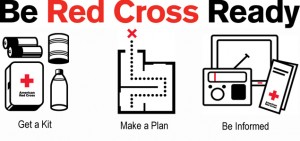A survey was taken a while back of 666 participants in relation to emergency preparedness. As you look over the survey results below, decide where YOU stand in relation to your family emergency plan:
Are you somewhat or partially prepared? 28% (186 votes) = I know what to do at the moment disaster strikes (earthquake/tornado/fire/hurricane), but I know I’ll wish I’d prepared better.
Are you working on a plan? 17% (116 votes) = I know what to do, but I still need to get it done.
Plan, what plan? = 42% (279 votes) NEARLY 1/2!!!
Every family should have a plan. Here's a checklist to make sure you are ready. I suggest grabbing a folder or binder to keep it all together in and just throw it in with your 72 hour kits.
Prepare Ahead:
□ meet with family members to discuss how to respond to the dangers of fire, severe weather, earthquakes, and other emergencies.□ find the safe spots in your home for each type of disaster
□ discuss what to do about power outages and injuries
□ draw a floor plan of your home and mark two escape routes from each room
□ post emergency phone numbers near telephones
□ teach children how and when to call 911, police, and fire
□ instruct family members to turn on the radio for information
□ pick one out-of-state and one local friend/family member to call in a disaster
□ pick two reunion locations, one right outside of your home, and one away from your neighborhood in case you cannot return
□ take a basic first aid and CPR class
Contact List:
Here is a list of contact information it would be wise to have figured out ahead of time, and stored in a safe place.Out-of-State-Contact:
Name:
City:
Telephone:
Local Contact:
Name:
Telephone:
Nearest Relative:
Name:
City:
Telephone:
Family Work Numbers:
Mother:
Father:
Other:
Emergency Telephone Numbers:
Police Department:
Fire Department:
Hospital:
Family Physicians:
Name:
Telephone:
Name:
Telephone:
Reunion Locations:
Right outside home:
Address:
Away from home:
Address:
Telephone:
Route to try first:
Disaster Supplies
□ supply of water (one gallon per person per day)□ first aid kit and prescription medications
□ extra pair of glasses or contacts
□ credit cards and cash
□ change of clothes and sturdy shoes
□ battery powered radio, and extra batteries
□ blankets or sleeping bags, rain poncho, body warmer
□ list of emergency plan contact info
□ booster cables for car, car shovel, rope, N95 dust mask, working gloves
□ flashlight with batteries
□ wind/waterproof matches, and candle
□ personal hygiene products (baby stuff, soap, tooth care, toilet paper)
□ games, books, hard candy, toys
□ duct tape, swiss army knife
Emergency Binder
This should be kept in a waterproof fire proof box. (You can get those at Target or Costco)
□ birth certificates□ passports
□ social security cards
□ copies of your credit cards front and back
□ homeowners insurance policy
□ auto insurance policy
□ life insurance policy
□ bank statements
□ retirement statements
□ utility statements
□ work/tax documents that would be difficult to replace
□ CASH – keep a variety of small bills on hand
Evacuation list
listen to a battery operated radio for the location of emergency shelters
have a plan for your pets. (crates or carriers for in the car etc.)
wear protective clothing and sturdy shoes
grab your disaster supply kit {72 hour kit}
lock your house
shut off water, gas, and electricity.
let others know when you left and where you are going.






No comments:
Post a Comment